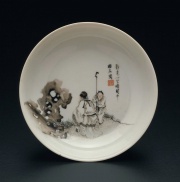Difference between revisions of "Porcelain"
Jump to navigation
Jump to search
m (Text replace - "\[http:\/\/cameo\.mfa\.org\/materials\/fullrecord\.asp\?name=([^\s]+)\s(.*)\]" to "$2") |
|||
| Line 1: | Line 1: | ||
| − | [[File:1982.99a-b-SC8918.jpg|thumb|]] | + | [[File:1982.99a-b-SC8918.jpg|thumb|Chinese teapot<br>MFA# 1982.99]] |
== Description == | == Description == | ||
A white, thin, translucent, [[ceramic|ceramic]] fired at temperatures above 1260 C. Porcelain was first made in China as early as the T'ang dynasty (618-907 CE). It was eventually made in Europe in 1707 by Johann Bottger in Meissen, Germany. Porcelain is made from a fine-grain mixture of [[kaolin|kaolin]] clay, [[quartz|quartz]], and [[feldspar|feldspar]]. At the high temperature, feldspar vitrifies to form the hard, dense, ceramic. | A white, thin, translucent, [[ceramic|ceramic]] fired at temperatures above 1260 C. Porcelain was first made in China as early as the T'ang dynasty (618-907 CE). It was eventually made in Europe in 1707 by Johann Bottger in Meissen, Germany. Porcelain is made from a fine-grain mixture of [[kaolin|kaolin]] clay, [[quartz|quartz]], and [[feldspar|feldspar]]. At the high temperature, feldspar vitrifies to form the hard, dense, ceramic. | ||
| − | [[File:61.1255-C20539CR-d1.jpg|thumb|]] | + | [[File:61.1255-C20539CR-d1.jpg|thumb|Qing dynasty bowl<br>MFA# 61.1255]] |
== Synonyms and Related Terms == | == Synonyms and Related Terms == | ||
Porzellan (Deut.); porcelana (Esp.); porcelaine (Fr.); porselein(Ned.); porcelana (Port.) | Porzellan (Deut.); porcelana (Esp.); porcelaine (Fr.); porselein(Ned.); porcelana (Port.) | ||
| + | == Physical and Chemical Properties == | ||
{| class="wikitable" | {| class="wikitable" | ||
|- | |- | ||
| Line 21: | Line 22: | ||
|} | |} | ||
| − | == | + | ==Resources and Citations== |
* G.S.Brady, ''Materials Handbook'', McGraw-Hill Book Co., New York, 1971 Comment: p. 428 | * G.S.Brady, ''Materials Handbook'', McGraw-Hill Book Co., New York, 1971 Comment: p. 428 | ||
| Line 31: | Line 32: | ||
* Robert Fournier, ''Illustrated Dictionary of Practical Pottery'', Chilton Book Company, Radnor, PA, 1992 | * Robert Fournier, ''Illustrated Dictionary of Practical Pottery'', Chilton Book Company, Radnor, PA, 1992 | ||
| − | * Wikipedia | + | * Wikipedia: http://en.wikipedia.org/wiki/Porcelain (Accessed Nov. 2, 2005) |
* ''The American Heritage Dictionary'' or ''Encarta'', via Microsoft Bookshelf 98, Microsoft Corp., 1998 | * ''The American Heritage Dictionary'' or ''Encarta'', via Microsoft Bookshelf 98, Microsoft Corp., 1998 | ||
Latest revision as of 13:41, 31 August 2020
Description
A white, thin, translucent, Ceramic fired at temperatures above 1260 C. Porcelain was first made in China as early as the T'ang dynasty (618-907 CE). It was eventually made in Europe in 1707 by Johann Bottger in Meissen, Germany. Porcelain is made from a fine-grain mixture of Kaolin clay, Quartz, and Feldspar. At the high temperature, feldspar vitrifies to form the hard, dense, ceramic.
Synonyms and Related Terms
Porzellan (Deut.); porcelana (Esp.); porcelaine (Fr.); porselein(Ned.); porcelana (Port.)
Physical and Chemical Properties
| Composition | 4K2O - Al2O3 - 3SiO2 |
|---|---|
| Mohs Hardness | 6 - 7 |
| Density | 2.41 |
Resources and Citations
- G.S.Brady, Materials Handbook, McGraw-Hill Book Co., New York, 1971 Comment: p. 428
- Ralph Mayer, A Dictionary of Art Terms and Techniques, Harper and Row Publishers, New York, 1969 (also 1945 printing)
- Dictionary of Building Preservation, Ward Bucher, ed., John Wiley & Sons, Inc., New York City, 1996
- Robert Fournier, Illustrated Dictionary of Practical Pottery, Chilton Book Company, Radnor, PA, 1992
- Wikipedia: http://en.wikipedia.org/wiki/Porcelain (Accessed Nov. 2, 2005)
- The American Heritage Dictionary or Encarta, via Microsoft Bookshelf 98, Microsoft Corp., 1998
- CRC Handbook of Chemistry and Physics, Robert Weast (ed.), CRC Press, Boca Raton, Florida, v. 61, 1980 Comment: density=2.3-2.5

